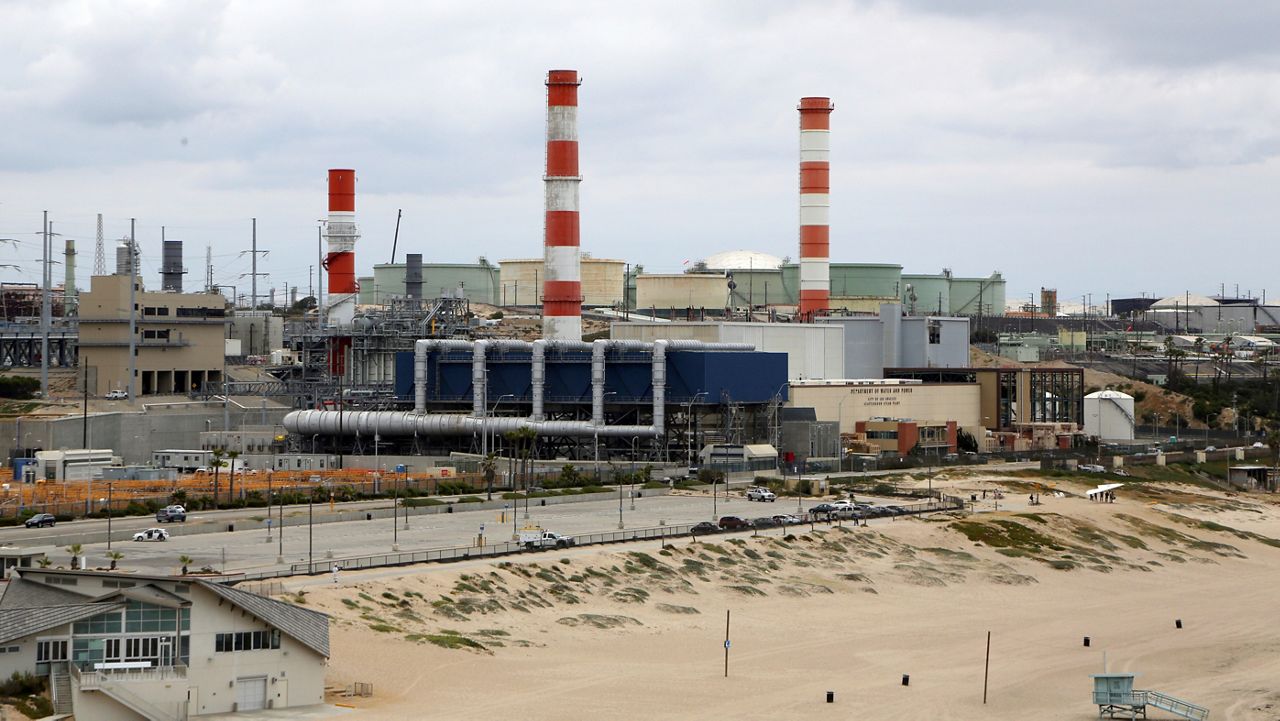LOS ANGELES (CNS) — The Los Angeles City Council voted Tuesday to move forward with a controversial plan to shift the Scattergood Generating Station, a power plant in Playa del Rey, to be powered by green hydrogen instead of natural gas.
The council voted 8-3 to approve a competitive bid proposal process for the estimated $800 million plan, over the objections of some environmental groups concerned about the impact of green hydrogen on the climate and lack of transparency from officials. The ordinance still needs a second vote for approval next week — when five new council members will have taken their seats. Two of the members who voted in favor and two who voted against it will be off the council by then.
The council’s vote came after a 2-1 approval by its energy committee. Council members Paul Koretz, Nithya Raman and Mike Bonin voted against the proposed ordinance, which authorizes the Los Angeles Department of Water and Power to award a contract for the project.
Council President Paul Krekorian called the plan necessary for Los Angeles to meet its goal of achieving 100% clean energy by 2035.
“The easiest thing to do is to say, ‘Climate change is a crisis,”‘ Krekorian said at a committee meeting last week. “It’s a lot harder to figure out: How do we address climate change in a city of four million people and ensure that we can keep the lights on?”
Without a significant generating resource at Scattergood, the city would see energy reliability issues, according to Krekorian, who added that the council was voting on just the procurement process.
“This is barely the first step on the beginning of a potential journey toward green hydrogen at Scattergood,” Krekorian said, adding that the council will be engaged in answering questions ahead of full approval.
According to a resolution approved by the Board of Water and Power Commissioners in August, the shift to green hydrogen would help the department reach its goal of transitioning to 100% renewable energy by 2035.
But environmental groups have pushed back. According to Food & Water Watch, hydrogen still produces emissions that can threaten the climate, would require more than 122 million gallons of water to power the plant and cost more than solar, wind or battery storage.
Jasmin Vargas, senior policy advisor at Food & Water Watch, called the process of the ordinance passing “perpetuating institutional racism,” with the end result disproportionately impacting Black and Brown communities. She wanted an alternative energy source that doesn’t combust hydrogen, and to shut down LADWP’s four plants in the Los Angeles Basin.
“You have no idea what you’re doing today,” Vargas told the council. “Having a gas plant, whether it’s hydrogen or natural gas, is still environmental racism.”
Several members of Pacoima Beautiful, an environmental justice organization, also expressed concern to the council about lack of discussion over potential health and economic impacts.
“Our communities can’t afford these false solutions,” said Annakaren Ramirez, the organization’s policy director. “We still don’t know where the water to produce hydrogen will be stored, where it will be made, any of the leak detection. We really just urge more time for these answers.”
Bonin, an outgoing council member who represents the Westside and will be replaced by Traci Park next week, submitted a letter to the energy committee echoing concerns about the project and vocalized his opposition Tuesday. He said the communities impacted by the project won’t be the “wealthy communities of the Westside,” but instead the communities of Inglewood, Hawthorne, Lawndale, Lennox and Gardena.
In the letter, Bonin stated that the full environmental impact of green hydrogen is unclear because it requires raw energy materials.
Bonin said hydrogen projects are being propped up by oil and gas companies, which may be hoping to blend hydrogen into their operations. He proposed narrowing the definition of green hydrogen to exclude hydrogen blending and combustions, and requiring all bidders for the contractor to detail environmental justice impacts.
During Tuesday’s meeting, Bonin projected that the $800 million price tag would shoot up to $1 billion -- money he said might be better spent on other resources. He also said the project would require an excessive amount of water.
“We’re in the middle of a drought,” Bonin said. “Where the hell are we getting hundreds of millions of dollars in fresh water?”
Jason Rondou, the LADWP’s director of resource planning, development and programs, said the Scattergood project is a means to creating a necessary renewable energy source for the city.
Rondou said the $800 million cost “appears significant,” but is just one of several projects working toward a renewable energy future. Scattergood is projected to account for less than 1% of Los Angeles’ energy portfolio by 2030, and the reduction in utilization will subsequently offset or even reduce water usage, according to Rondou.
But the 1% is important because “if we have wildfires, if we have earthquakes, it is that less than 1% that will keep the grid reliable and stable so that we can continue to charge our electric vehicles, and we can continue to power our homes and businesses — which will be fully electrified in the future,” Rondou said.
Koretz, another outgoing council member, said during last week’s committee meeting that lobbyists from SoCalGas “looked me in the eye and told me they intended to use hydrogen to keep the methane flowing for as long as possible,” noting his distrust for the utilities company.
“I do think we need to make the hard decision and the hard choices and do the work, but I’m just not there yet on this one,” Koretz said.
Marcelo DiPaolo, power engineering manager for LADWP, told the committee that hydrogen burns at lower temperatures, which reduces emissions.
One stakeholder backing the project was Matt Dickinson, sustainability director for Fenix Marine Services. Dickinson told the council that the company, which operates at the Port of Los Angeles, is developing two hydrogen- powered cargo handlers.
“They are performing well and we expect to expand that fleet,” Dickinson said. “We cannot do it meaningfully if we do not have a supply of green hydrogen available to use.”
In explaining the LADWP’s perspective of the plan, Rondou said there are “several remaining questions that need to be answered.”
“Some of them we know today,” Rondou said. “Some, we don’t know, and we’ll find out over the coming decade.”










